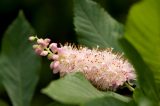
Wetland Adaptations
Over time and generations, plants and animals change in a variety of ways and develop specific features in order to survive. This process is known as adaptation. Plants and animals living in wetland areas have adaptations suited to the moist conditions of their surroundings.
Cattails

Cattails (Typha latifolia) grow in the muddy water at the edges of ponds and lakes. Their tall stiff stems extend high above the water and other nearby plants, which helps them take in more sunlight. Large airspaces in the stems and roots help cattails get oxygen to all parts of the plant.
Patches of cattails are natural hiding places for many insects, birds, and small mammals. Red-winged blackbirds build nests among the cattails using the plants’ leaves, stems, and flowers, and many animals eat the seeds.
Water Lilies

The round leaves of water lilies (Nymphaea sp.) float on the surface of the water while the stems and roots grow in soil and below where oxygen is in short supply. While many plants use both their leaves and roots to get the oxygen needed to live, water lilies rely on their leaves for air.
The leaves also enable water lilies to float above the surface of the water. Inside each leaf are tiny air pockets, and the outside has a waxy coating. This coating causes water to roll off the leaf instead of weighing it down. This adaptation allows damselflies, dragonflies, and other insects to use the tops of water lilies for resting or even laying their eggs.
Willows

Willow trees (Salix sp.) thrive in moist environments and grow naturally near bodies of water. Their far-reaching and dense roots enable them to absorb water while anchoring them firmly in the wet soil.
This adaptation and others benefit the wetland ecosystem. The extensive roots system helps to prevent soil erosion, stabilizing the soil and providing a place for other plants to grow. Willows also grow fast in their native environments, quickly creating shade and shelter for animals and shade-tolerant plants.












